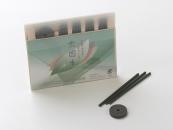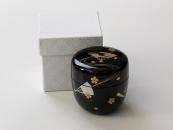- Customer Appreciation
- Tencha - Pure Elegant Flavor
- Iced Tea Recipes
- Four Seasons of Green Tea
- Green Tea for Health
- How to Enjoy Green Tea
- History of Green Tea
- Benefits of Matcha
- Japanese Tea Ceremony
- Organic Tea Farm
- Celebration Gifts in Japan
- Choosing a Japanese Tea
- Choosing Tea Ware
- Traveling around Uji
- Shincha News Flash
- RAKU YAKI - Avantgarde to Tradition

- Customer AppreciationIncluded FREE with all orders for 2,400 customers

- Tencha (Limited)Quite unique, pure, noble, and elegant flavor

- Shincha Matcha (Limited)Feel delight of the spring season, inspired by fresh flavor

- Tencha - Pure Elegant FlavorEnjoyed in secret among only a few Matcha manufacturers

- Summer Elegant Yunomi & Matcha BowlModern sophisticated / traditional handcrafted

- [Limited] Snacks & Candy (Summer)Premium, Traditional & Modern

Matcha Bowls/Accessories
All of our Matcha Bowls / Accessories are carefully selected for their function, value, and style. We have a wide variety of items: handmade matcha bowls, bamboo accessories for matcha, and much more.

Best Selling Items- Monthly
-
1
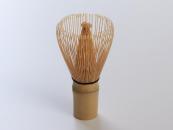 Bamboo Whisk 100 bristles (Chasen)
US$35.50
Bamboo Whisk 100 bristles (Chasen)
US$35.50
-
2
 Whisk Keeper (Kusenaoshi)
US$14.50
Whisk Keeper (Kusenaoshi)
US$14.50
-
3
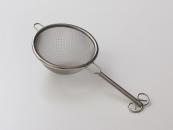 Hand Sifter (Chakoshi)
US$12.50
Hand Sifter (Chakoshi)
US$12.50
-
4
![[New] KATAKUCHI Matcha Bowl(handcrafted Bowl with pour spout) [New] KATAKUCHI Matcha Bowl(handcrafted Bowl with pour spout)](/images/upload/thumbnail/KATAKUCHI-Matcha-Bowl_A01.jpg) [New] KATAKUCHI Matcha Bowl(handcrafted Bowl with pour spout)
US$44.50
[New] KATAKUCHI Matcha Bowl(handcrafted Bowl with pour spout)
US$44.50
-
5
 Matcha Sifter
US$19.00
Matcha Sifter
US$19.00
-
6
![[New] KIJICAN (airtight container: pair: capacity 40g) [New] KIJICAN (airtight container: pair: capacity 40g)](/images/upload/thumbnail/KIJICAN-Chazutsu-40g_A01.jpg) [New] KIJICAN (airtight container: pair: capacity 40g)
US$20.00
[New] KIJICAN (airtight container: pair: capacity 40g)
US$20.00
-
7
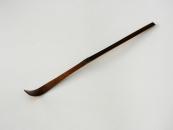 SUSUDAKE Chashaku (handcrafted Matcha Spoon)
US$19.50
SUSUDAKE Chashaku (handcrafted Matcha Spoon)
US$19.50
-
8
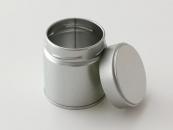 Matcha Container (capacity 40g)
US$7.00
Matcha Container (capacity 40g)
US$7.00
-
9
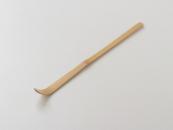 Chashaku (Matcha Spoon)
US$14.50
Chashaku (Matcha Spoon)
US$14.50
-
10
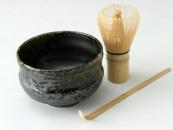 BEEDORO Matcha Starter Set
US$77.00
BEEDORO Matcha Starter Set
US$77.00
-
11
![[Limited] KIYOMIZU DERA - SAKURA GESHIKI Matcha Starter Set [Limited] KIYOMIZU DERA - SAKURA GESHIKI Matcha Starter Set](/images/upload/thumbnail/KIYOMIZUDERA-SAKURA-ST_A01.jpg) [Limited] KIYOMIZU DERA - SAKURA GESHIKI Matcha Starter Set
US$148.00
[Limited] KIYOMIZU DERA - SAKURA GESHIKI Matcha Starter Set
US$148.00
-
12
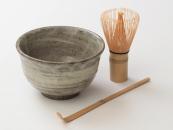 Starter Set for Matcha Tea Ware
US$71.00
Starter Set for Matcha Tea Ware
US$71.00
-
13
![[New] SEIHAKUJI Matcha Starter Set [New] SEIHAKUJI Matcha Starter Set](/images/upload/thumbnail/SEIHAKUJI-StarterSet_A01.jpg) [New] SEIHAKUJI Matcha Starter Set
US$63.00
[New] SEIHAKUJI Matcha Starter Set
US$63.00
-
14
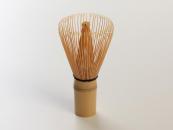 Bamboo Whisk 80 bristles (Chasen)
US$31.50
Bamboo Whisk 80 bristles (Chasen)
US$31.50
-
15
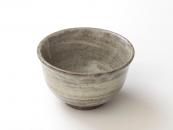 Matcha Chawan (Matcha Bowl)
US$37.00
Matcha Chawan (Matcha Bowl)
US$37.00
-
![[Limited] KIYOMIZU DERA - SAKURA GESHIKI Matcha Starter Set [Limited] KIYOMIZU DERA - SAKURA GESHIKI Matcha Starter Set](/images/upload/thumbnail/KIYOMIZUDERA-SAKURA-ST_A01.jpg) Limited 31054 US$148.00 KIYOMIZU DERA - SAKURA GESHIKI Matcha Starter Set
Limited 31054 US$148.00 KIYOMIZU DERA - SAKURA GESHIKI Matcha Starter SetThis Starter Set includes a Matcha Bowl (Matcha Chawan), Bamboo Whisk (Chasen) with 100 bristles, Whisk Keeper (Kusenaoshi), and Matcha Spoon (Chashaku). We chose KIYOMIZUDERA - SAKURA GESHIKI handcrafted Matcha Bowl, painted elegantly by typical Kyo Yaki style...

-
![[KIRAI] SHIRO CHAWAN - TSURUGIDAKE (handcrafted Matcha Bowl) [KIRAI] SHIRO CHAWAN - TSURUGIDAKE (handcrafted Matcha Bowl)](/images/upload/thumbnail/SHIRO_CHAWAN_TSURUGIDAKE_A01.jpg) KIRAI 33130 US$1,980.00 SHIRO CHAWAN - TSURUGIDAKE (handcrafted Matcha Bowl)
KIRAI 33130 US$1,980.00 SHIRO CHAWAN - TSURUGIDAKE (handcrafted Matcha Bowl)TSURUGIDAKE is a famous mountain range in Japan, about 3,000 meters above sea level. This mountain in Toyama Prefecture is one of the few mountains in Japan with an existing glacier. TSURUGIDAKE means "Mountain of Swords" and its steepness is so extreme that it has been said for centuries to be extremely dangerous to climb.......

-
![[KIRAI] RANSAI CHAWAN (handcrafted Matcha Bowl) [KIRAI] RANSAI CHAWAN (handcrafted Matcha Bowl)](/images/upload/thumbnail/RANSAI_CHAWAN_A01.jpg) KIRAI 33140 US$1,980.00 RANSAI CHAWAN (handcrafted Matcha Bowl)
KIRAI 33140 US$1,980.00 RANSAI CHAWAN (handcrafted Matcha Bowl)RANSAI means indigo blue color. This unique noble blue color is completely original to the artisan, Kyoshitu Sasaki. While based on RAKU-yaki's traditional style, this masterpiece is the result of his constant research and challenge, and is filled with the latest ideas at the moment......

-
![[Tale of Genji] AOI (handcrafted Matcha Bowl) [Tale of Genji] AOI (handcrafted Matcha Bowl)](/images/upload/thumbnail/AOI_A01.jpg) Tale of Genji 34010 US$343.00 AOI (handcrafted Matcha Bowl)
Tale of Genji 34010 US$343.00 AOI (handcrafted Matcha Bowl)AOI is the name of the first wife of Hikaru Genji. This story is one of the famous quires in the Tale of Genji. Most of them are written statically, but Murasaki Shikibu, who is the author of Tale of Genji describes this scene dynamically...

-
![[Tale of Genji] MIOTSUKUSHI (handcrafted Matcha Bowl) [Tale of Genji] MIOTSUKUSHI (handcrafted Matcha Bowl)](/images/upload/thumbnail/MIOTSUKUSHI_A01.jpg) Tale of Genji 34013 US$343.00 MIOTSUKUSHI (handcrafted Matcha Bowl)
Tale of Genji 34013 US$343.00 MIOTSUKUSHI (handcrafted Matcha Bowl)On this Matcha bowl, the place where Hikaru Genji and AKASHI NO KIMI happened to meet at the shrine is decorated. A large, red shrine gate is placed on the center of the bowl. Its color contrast between red and green is well matched. Each pattern of KANNYU cracking is so different that each bowl has a unique pattern...

-
![[Limited] MANKAI no SAKURA Matcha Bowl (handcrafted) [Limited] MANKAI no SAKURA Matcha Bowl (handcrafted)](/images/upload/thumbnail/MANKAI-no-SAKURA_A01.jpg) Limited 34106 US$234.00 MANKAI no SAKURA Matcha Bowl (handcrafted)
Limited 34106 US$234.00 MANKAI no SAKURA Matcha Bowl (handcrafted)Zenshoh Yamaoka carefully painted the petals of the cherry blossoms one by one. You can see that the petals are thick. This is because he applies layers of the paints several times and he repeats painting and firing until all petals become the same thickness and smoothness. It takes a lot of work and requires high skill because the paints are quite difficult to use...

-
![[Limited] SEISAN TENMOKU (handcrafted Matcha Bowl) [Limited] SEISAN TENMOKU (handcrafted Matcha Bowl)](/images/upload/thumbnail/SEISAN-TENMOKU_A01.jpg) Limited 34652 US$204.00 SEISAN TENMOKU (handcrafted Matcha Bowl)
Limited 34652 US$204.00 SEISAN TENMOKU (handcrafted Matcha Bowl)This pottery Matcha bowl creates an aura of elegance and nobility. This Matcha bowl is part of a new line of TENMOKU tea ware from Tohan Kiln. The shape is one of the traditional forms, which is used for TENMOKU Chawan. The shape matches with the elegant glaze very well...

-
![[Limited] KIN SHOHBU (handcrafted Matcha Bowl) [Limited] KIN SHOHBU (handcrafted Matcha Bowl)](/images/upload/thumbnail/KIN-SHOHBU_A01.jpg) Limited 34904 US$178.00 KIN SHOHBU (handcrafted Matcha Bowl)
Limited 34904 US$178.00 KIN SHOHBU (handcrafted Matcha Bowl)Beautiful and lively HANA SHOHBU flower iris, which is colored white and deep blue, are carefully and boldly drawn on the surface of this bowl. The light green leaves accentuate the vigor of the HANA SHOHBU and the Matcha bowl. All flowers and leaves colored in gold add elegance and luxury to this Matcha bowl...

-
![[Limited] MISHIMA KAMON (handcrafted Matcha Bowl) [Limited] MISHIMA KAMON (handcrafted Matcha Bowl)](/images/upload/thumbnail/MISHIMA-KAMON_A01.jpg) Limited 34914 US$178.00 MISHIMA KAMON (handcrafted Matcha Bowl)
Limited 34914 US$178.00 MISHIMA KAMON (handcrafted Matcha Bowl)MISHIMA KAMON has a sophisticated and unique atmosphere. KAMON means flower crest in Japanese. Various types of INKA stamps of flowers are decorated inside and outside of the bowl. Fine patterns and deep maroon color clay create luxurious beauty...

-
![[Limited] HANA KESSHO SABI ASAGI (handcrafted Matcha Bowl) [Limited] HANA KESSHO SABI ASAGI (handcrafted Matcha Bowl)](/images/upload/thumbnail/HANAKESSHOH-SABIASAGI_A01.jpg) Limited 34916 US$178.00 HANA KESSHO SABI ASAGI (handcrafted Matcha Bowl)
Limited 34916 US$178.00 HANA KESSHO SABI ASAGI (handcrafted Matcha Bowl)This pottery Matcha bowl creates an aura of elegance and a unique pleasant cooling sensation. It is said that it is very difficult for porcelain or earthenware to evoke the sensation of cooling. This Matcha bowl is part of a new line of HANA KESSHO tea ware. Other HANA KESSHO lines are porcelain but this new line is pottery. The fact that it is pottery instead of porcelain helps to create the unique aura...

-
![[Limited] KIIRABO - HARU no MOEGI (handcrafted Matcha Bowl) [Limited] KIIRABO - HARU no MOEGI (handcrafted Matcha Bowl)](/images/upload/thumbnail/KIIRABO-HARUnoMOEGI_A01.jpg) Limited 35401 US$130.00 KIIRABO - HARU no MOEGI (handcrafted Matcha Bowl)
Limited 35401 US$130.00 KIIRABO - HARU no MOEGI (handcrafted Matcha Bowl)This kind of Matcha bowl is called IRABO. Which is a type of traditional stoneware and it was introduced to Japan around the 16th or 17th century. Eizan Okuda uses the deep green glaze BEEDORO, which is one of the most traditional glazes of Shigaraki Yaki. The shiny deep green glaze creates a beautiful spring atmosphere...

-
![[Limited] TOBIKANNA ZIMON AOYU (handcrafted Matcha Bowl) [Limited] TOBIKANNA ZIMON AOYU (handcrafted Matcha Bowl)](/images/upload/thumbnail/TOBIKANNAZIMON-AOYU_A01.jpg) Limited 35402 US$130.00 TOBIKANNA ZIMON AOYU (handcrafted Matcha Bowl)
Limited 35402 US$130.00 TOBIKANNA ZIMON AOYU (handcrafted Matcha Bowl)The pale blue color of this Matcha bowl is very impressive. It adds a cool impression and is in harmony with the flat form of this bowl and TOBIKANNA patterns. Eizan Okuda uses this blue color glaze called AOYU, which is inspired by Biidoro glass...

-
![[Limited] HANA KESSHO RURI (handcrafted Matcha Bowl) [Limited] HANA KESSHO RURI (handcrafted Matcha Bowl)](/images/upload/thumbnail/HANA_KESSHO_RURI_A01.jpg) Limited 35605 US$125.00 HANA KESSHO RURI (handcrafted Matcha Bowl)
Limited 35605 US$125.00 HANA KESSHO RURI (handcrafted Matcha Bowl)This porcelain Matcha Bowl creates an aura of elegance and unique pleasant cooling sensation. Glaze of RURI lapis lazuli blue color covers inside and outside the Matcha bowl, evoking the image that the Matcha bowl is adorned with lapis lazuli. Not only the crystal glaze but also its color gives us an image of cool atmosphere...

-
![[Limited] SAKURA ni FUJI (handcrafted Matcha Bowl) [Limited] SAKURA ni FUJI (handcrafted Matcha Bowl)](/images/upload/thumbnail/SAKURA-ni-FUJI_A01.jpg) Limited 36011 US$108.00 SAKURA ni FUJI (handcrafted Matcha Bowl)
Limited 36011 US$108.00 SAKURA ni FUJI (handcrafted Matcha Bowl)This scene is a traditional symbol of springtime in Japan. Mt. Fuji is covered with snow and we understand that this is a scene of the beginning of spring. The use of golden clouds in the background makes this Matcha bowl bright and luxurious...

-
![[Limited] MISHIMADE (handcrafted Matcha Bowl) [Limited] MISHIMADE (handcrafted Matcha Bowl)](/images/upload/thumbnail/MISHIMADE_A01.jpg) Limited 36018 US$96.00 MISHIMADE (handcrafted Matcha Bowl)
Limited 36018 US$96.00 MISHIMADE (handcrafted Matcha Bowl)Flowers pattern by MISHIMA technique are applied to the outside of the bowl. Each flower pattern is impressed uniquely. A few lines are horizontally carved at the rim and bottom of the bowl. This line adds a little sharpness and tightens the appearance of the design...

-
![[Limited] HANA KESSHO White (handcrafted Matcha Bowl) [Limited] HANA KESSHO White (handcrafted Matcha Bowl)](/images/upload/thumbnail/HanaKesshoMatchaWhite_A01.jpg) Limited 37307 US$108.00 HANA KESSHO White (handcrafted Matcha Bowl)
Limited 37307 US$108.00 HANA KESSHO White (handcrafted Matcha Bowl)HANA of this name means flower and KESSHO means crystal in Japanese. This item is finished by the technique called Crystal glaze. This can be used not only for Matcha but also for serving traditional Japanese snacks and other foods. It will expand in application depending on your idea…

-
![[New] SEIHAKUJI Matcha Chawan (Porcelain Matcha Bowl) [New] SEIHAKUJI Matcha Chawan (Porcelain Matcha Bowl)](/images/upload/thumbnail/SEIHAKUJI-Matcha-Chawan_A01.jpg) New 38503 US$31.00 SEIHAKUJI Matcha Chawan (Porcelain Matcha Bowl)
New 38503 US$31.00 SEIHAKUJI Matcha Chawan (Porcelain Matcha Bowl)SEI means blue in Japanese. SEIHAKUJI is a kind of HAKUJI (white porcelain) with a glaze that is a beautiful light blue. SEIHAKUJI was held in high esteem by nobles such as Japanese feudal lords. The pale blue color evokes a clean and calm atmosphere...

-
![[KIRAI] SHIRO CHAWAN - TSURUGIDAKE (handcrafted Matcha Bowl) [KIRAI] SHIRO CHAWAN - TSURUGIDAKE (handcrafted Matcha Bowl)](/images/upload/thumbnail/SHIRO_CHAWAN_TSURUGIDAKE_A01.jpg) KIRAI 33130 US$1,980.00 SHIRO CHAWAN - TSURUGIDAKE (handcrafted Matcha Bowl)
KIRAI 33130 US$1,980.00 SHIRO CHAWAN - TSURUGIDAKE (handcrafted Matcha Bowl)TSURUGIDAKE is a famous mountain range in Japan, about 3,000 meters above sea level. This mountain in Toyama Prefecture is one of the few mountains in Japan with an existing glacier. TSURUGIDAKE means "Mountain of Swords" and its steepness is so extreme that it has been said for centuries to be extremely dangerous to climb.......

-
![[KIRAI] RANSAI CHAWAN (handcrafted Matcha Bowl) [KIRAI] RANSAI CHAWAN (handcrafted Matcha Bowl)](/images/upload/thumbnail/RANSAI_CHAWAN_A01.jpg) KIRAI 33140 US$1,980.00 RANSAI CHAWAN (handcrafted Matcha Bowl)
KIRAI 33140 US$1,980.00 RANSAI CHAWAN (handcrafted Matcha Bowl)RANSAI means indigo blue color. This unique noble blue color is completely original to the artisan, Kyoshitu Sasaki. While based on RAKU-yaki's traditional style, this masterpiece is the result of his constant research and challenge, and is filled with the latest ideas at the moment......

-
![[Limited] KURO IWANAMI - KUTSUGATA (handcrafted Matcha bowl) [Limited] KURO IWANAMI - KUTSUGATA (handcrafted Matcha bowl)](/images/upload/thumbnail/KURO-IWANAMI-KUTSUGATA_A01.jpg) Limited 33301 US$845.00 KURO IWANAMI - KUTSUGATA (handcrafted Matcha bowl)
Limited 33301 US$845.00 KURO IWANAMI - KUTSUGATA (handcrafted Matcha bowl)KURO IWANAMI means waves crashing on black rocks in Japanese. This Matcha bowl is very avant-garde, yet it is based on traditional techniques, and created uniquely by the artisan, Mr. Sako. It is ideal for tea ceremonies, and holding it in both hands is inexplicably calming.

-
![[Limited] KURO IWANAMI - HIRAGATA (handcrafted Matcha bowl) [Limited] KURO IWANAMI - HIRAGATA (handcrafted Matcha bowl)](/images/upload/thumbnail/KURO-IWANAMI-HIRAGATA_A01.jpg) Limited 33302 US$845.00 KURO IWANAMI - HIRAGATA (handcrafted Matcha bowl)
Limited 33302 US$845.00 KURO IWANAMI - HIRAGATA (handcrafted Matcha bowl)KURO IWANAMI means waves crashing on black rocks in Japanese. This Matcha bowl is very avant-garde, yet it is based on traditional techniques, and created uniquely by the artisan, Mr. Sako. It is ideal for tea ceremonies, and holding it in both hands is inexplicably calming.

-
![[Limited] KURO IWANAMI - TSUTSUGATA (handcrafted Matcha bowl) [Limited] KURO IWANAMI - TSUTSUGATA (handcrafted Matcha bowl)](/images/upload/thumbnail/KURO-IWANAMI-TSUTSUGATA_A01.jpg) Limited 33303 US$845.00 KURO IWANAMI - TSUTSUGATA (handcrafted Matcha bowl)
Limited 33303 US$845.00 KURO IWANAMI - TSUTSUGATA (handcrafted Matcha bowl)KURO IWANAMI means waves crashing on black rocks in Japanese. This Matcha bowl is very avant-garde, yet it is based on traditional techniques, and created uniquely by the artisan, Mr. Sako. It is ideal for tea ceremonies, and holding it in both hands is inexplicably calming.

-
![[NIJO Castle KANO] MATSU TAKA ZU (by Zenshoh Yamaoka) [NIJO Castle KANO] MATSU TAKA ZU (by Zenshoh Yamaoka)](/images/upload/thumbnail/Matsutakazu_A01.jpg) NIJO Castle KANO 33351 US$791.00 MATSU TAKA ZU (by Zenshoh Yamaoka)
NIJO Castle KANO 33351 US$791.00 MATSU TAKA ZU (by Zenshoh Yamaoka)MATSU TAKA ZU was painted for the OHIROMA great hall, where is decorated with paintings that honored the SHOGUN emperor. When the DAIMYO vassal lords looked up to see the SHOGUN emperor, they felt as if the great pine tree arced above the SHOGUN emperor...

-
![[NIJO Castle KANO] KIKU ZU (by Zenshoh Yamaoka) [NIJO Castle KANO] KIKU ZU (by Zenshoh Yamaoka)](/images/upload/thumbnail/Kikuzu_A01.jpg) NIJO Castle KANO 33352 US$750.00 KIKU ZU (by Zenshoh Yamaoka)
NIJO Castle KANO 33352 US$750.00 KIKU ZU (by Zenshoh Yamaoka)KIKU ZU was painted for the KUROSHOIN rooms, where the SHOGUN emperor carried out everyday tasks with his followers, are decorated with relaxing, elegant, and gentle paintings of birds, flowers, trees, and so on in order to create an atmosphere of abundant fertility...

-
![[NIJO Castle KANO] CHIKURIN GUNKO ZU (by Zenshoh Yamaoka) [NIJO Castle KANO] CHIKURIN GUNKO ZU (by Zenshoh Yamaoka)](/images/upload/thumbnail/Chikuringunkozu_A01.jpg) NIJO Castle KANO 33353 US$658.00 CHIKURIN GUNKO ZU (by Zenshoh Yamaoka)
NIJO Castle KANO 33353 US$658.00 CHIKURIN GUNKO ZU (by Zenshoh Yamaoka)CHIKURIN GUNKO ZU was painted for the west wing of TOHZAMURAI great entrance hall, where is decorated with strong, dynamic paintings in order to show the dignity of the SHOGUN emperor to DAIMYO vassal lords. DAIMYO vassal lords should have felt awed to see paintings of the tiger pride...

-
![[NIJO Castle KANO] ROGAN ZU (by Zenshoh Yamaoka) [NIJO Castle KANO] ROGAN ZU (by Zenshoh Yamaoka)](/images/upload/thumbnail/Roganzu_A01.jpg) NIJO Castle KANO 33354 US$658.00 ROGAN ZU (by Zenshoh Yamaoka)
NIJO Castle KANO 33354 US$658.00 ROGAN ZU (by Zenshoh Yamaoka)ROGAN ZU was painted for the anterooms of the SHIKIDAI rooms, where are decorated with affable, kindly, and elegant paintings to cultivate a feeling of warm hospitality. This ROGAN ZU is popular because of the affable, kindly, and elegant atmosphere...

-
![[Shouraku] SHICHIRI (handcrafted Matcha Bowl) [Shouraku] SHICHIRI (handcrafted Matcha Bowl)](/images/upload/thumbnail/Shichiri_A01.jpg) Shouraku 33603 US$449.00 SHICHIRI (handcrafted Matcha Bowl)
Shouraku 33603 US$449.00 SHICHIRI (handcrafted Matcha Bowl)The sides of this piece are deliberately and boldly whittled away. It evokes a very powerful impression, as though we are gazing upon a great rocky cliff. The foot of this bowl is intentionally finished low and the scene from the bottom to the middle of the side is sublime and tension-filled...

-
![[Shouraku] OTOKOZE (handcrafted Matcha Bowl) [Shouraku] OTOKOZE (handcrafted Matcha Bowl)](/images/upload/thumbnail/Otokoze_A01.jpg) Shouraku 33605 US$397.00 OTOKOZE (handcrafted Matcha Bowl)
Shouraku 33605 US$397.00 OTOKOZE (handcrafted Matcha Bowl)The form of this bowl faithfully reproduces the original work of Kohetsu Honami. Kohetsu is famous for producing novel and avant-garde works. The round shape like this OTOKOZE bowl is a textbook example. Its form and size surprisingly fit into both hands when drinking Matcha, in contrast with the unique and novel appearance...

-
![[Tale of Genji] AOI (handcrafted Matcha Bowl) [Tale of Genji] AOI (handcrafted Matcha Bowl)](/images/upload/thumbnail/AOI_A01.jpg) Tale of Genji 34010 US$343.00 AOI (handcrafted Matcha Bowl)
Tale of Genji 34010 US$343.00 AOI (handcrafted Matcha Bowl)AOI is the name of the first wife of Hikaru Genji. This story is one of the famous quires in the Tale of Genji. Most of them are written statically, but Murasaki Shikibu, who is the author of Tale of Genji describes this scene dynamically...

-
![[Tale of Genji] MIOTSUKUSHI (handcrafted Matcha Bowl) [Tale of Genji] MIOTSUKUSHI (handcrafted Matcha Bowl)](/images/upload/thumbnail/MIOTSUKUSHI_A01.jpg) Tale of Genji 34013 US$343.00 MIOTSUKUSHI (handcrafted Matcha Bowl)
Tale of Genji 34013 US$343.00 MIOTSUKUSHI (handcrafted Matcha Bowl)On this Matcha bowl, the place where Hikaru Genji and AKASHI NO KIMI happened to meet at the shrine is decorated. A large, red shrine gate is placed on the center of the bowl. Its color contrast between red and green is well matched. Each pattern of KANNYU cracking is so different that each bowl has a unique pattern...

-
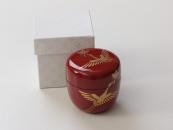 39120 US$58.00 Natsume - MATSUKUI TSURU (handcrafted canister)
39120 US$58.00 Natsume - MATSUKUI TSURU (handcrafted canister)NATSUME is a Matcha container traditionally used in the Japanese tea ceremony. MATSU means pine, and TSURU means crane in Japanese. Both of them have been regarded as the traditional auspicious composition symbolizing longevity in Japan...

-
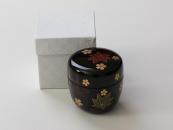 39130 US$58.00 Natsume - SAKURA MOMIJI (handcrafted canister)
39130 US$58.00 Natsume - SAKURA MOMIJI (handcrafted canister)This canister expresses the four seasons in Japan by cherry blossoms and maple leaves. All flowers and leaves flutter elegantly in this canister. TAME is a specific color of lacquer craft. The color is a rich dark brown, and it is one of the most traditional colors of Yamanaka Nuri...

-
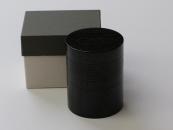 39161 US$110.00 KEYAKI KURO MEHAJIKI (handcrafted container; capacity 60g)
39161 US$110.00 KEYAKI KURO MEHAJIKI (handcrafted container; capacity 60g)The wood is from the Zelkova tree, known as KEYAKI in Japan. Japanese artisans use KEYAKI for traditional wooden lacquer because the wood is strong and the grain is quite beautiful. KURO means black, and MEHAJIKI is one of the craft techniques used to paint lacquer. The glossy and deep black color evokes a noble and majestic atmosphere...

-
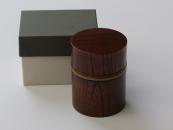 39162 US$114.00 KEYAKI KOMANURI (handcrafted container; capacity 60g)
39162 US$114.00 KEYAKI KOMANURI (handcrafted container; capacity 60g)The stripe design on this tea container is called KOMA NURI in Japanese. KOMA means a toy spinning top, and NURI means painting in Japanese. KOMA is a traditional toy, played with during the New Year holiday celebration in Japan, and is said to be an auspicious item...









![[Limited] SATSUKI Matcha Starter Set [Limited] SATSUKI Matcha Starter Set](/images/upload/thumbnail/SATSUKI-StarterSet_A01.jpg)
![[Limited] MISHIMADE Matcha Starter Set [Limited] MISHIMADE Matcha Starter Set](/images/upload/thumbnail/MISHIMADE-StarterSet_A01.jpg)
![[Limited] HANA KESSHO White Matcha Starter Set [Limited] HANA KESSHO White Matcha Starter Set](/images/upload/thumbnail/HanaKesshoMatchaWhite-StarterSet_A01.jpg)
![[Limited] KINPAKU TAKE (handcrafted Matcha Bowl) [Limited] KINPAKU TAKE (handcrafted Matcha Bowl)](/images/upload/thumbnail/KINPAKU_TAKE_A01.jpg)
![[Limited] MOEGI (handcrafted Matcha Bowl) [Limited] MOEGI (handcrafted Matcha Bowl)](/images/upload/thumbnail/MOEGI_A01.jpg)
![[Limited] KISSHOH OSHIDORI (handcrafted Matcha Bowl) [Limited] KISSHOH OSHIDORI (handcrafted Matcha Bowl)](/images/upload/thumbnail/KISSHO_OSHIDORI_A01.jpg)
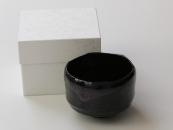

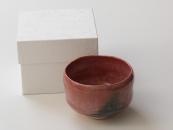
![[Limited] KIYOMIZU DERA - SAKURA GESHIKI (handcrafted) [Limited] KIYOMIZU DERA - SAKURA GESHIKI (handcrafted)](/images/upload/thumbnail/KIYOMIZUDERA-SAKURA_A01.jpg)
![[Limited] SATSUKI (handcrafted Matcha Bowl) [Limited] SATSUKI (handcrafted Matcha Bowl)](/images/upload/thumbnail/SATSUKI_A01.jpg)
![[Limited] HANA KESSHO RURI - Flat (handcrafted Matcha Bowl) [Limited] HANA KESSHO RURI - Flat (handcrafted Matcha Bowl)](/images/upload/thumbnail/HANA-KESSHO-RURI-Flat_A01.jpg)
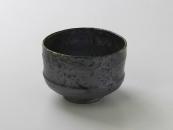
![[Shouraku] KURO MAKUGUSURI CHAWAN (by Shouraku III) [Shouraku] KURO MAKUGUSURI CHAWAN (by Shouraku III)](/images/upload/thumbnail/KuroMakugusuriChawan_A01.jpg)
![[Shouraku] AKA MAKUGUSURI CHAWAN (by Shohraku III) [Shouraku] AKA MAKUGUSURI CHAWAN (by Shohraku III)](/images/upload/thumbnail/AkaMakugusuriChawan_A01.jpg)
![[Shouraku] SAMIDARE (handcrafted Matcha Bowl) [Shouraku] SAMIDARE (handcrafted Matcha Bowl)](/images/upload/thumbnail/Samidare_A01.jpg)
![[Shouraku] MUKIGURI (handcrafted Matcha Bowl) [Shouraku] MUKIGURI (handcrafted Matcha Bowl)](/images/upload/thumbnail/Mukiguri_A01.jpg)
![[Shouraku] FUJISAN (handcrafted Matcha Bowl) [Shouraku] FUJISAN (handcrafted Matcha Bowl)](/images/upload/thumbnail/Fujiyama_A01.jpg)
